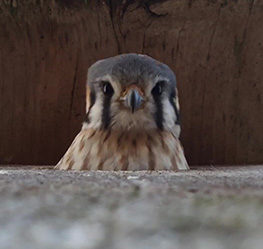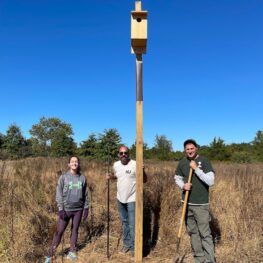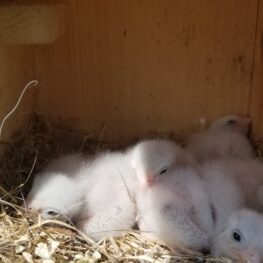Kestrels are ambassadors for the connection between what we do on the land and the health of our water. – Dr. Kristi MacDonald, RHA Science Director

Adult male American Kestrel peaking out of a nest box on a partner property. Photo by Bill Pitts.
Meet the American Kestrel, our smallest falcon species. It is one of the most colorful and widespread raptors in North America. Insects as well as small birds and rodents make up their preferred diet. When hunting, they often spend time perched in open areas on telephone wires and fence posts, so you have likely seen one before.
Kestrels were once very common in the Upper Raritan, but over the past 50 years they have become rare as their populations have declined by over 80 percent in the northeastern United States. Kestrels prefer open habitats such as meadows, pastures, agricultural fields, and forest clearings, which are abundant in the Upper Raritan Region of New Jersey. They are cavity-nesters (nest in holes), often in large, isolated trees in open fields. With the advent of “clean” farming practices removal of trees and brush between working fields has become common and with it the loss of preferred nest sites for kestrels. While factors such as loss of habitat, use of pesticides, planting of monocultures of row crops, and competition for nest sites by invasive species (e.g., European Starling) contribute to the decline of kestrels, placing nest boxes throughout our watershed will promote their recovery.

Installing kestrel nest boxes with Somerset County Parks. Left to right, Madison Purguy (RHA Kestrel Intern), Bill Pitts (NJ Fish and Wildlife biologist), and Rob (Somerset County Parks).
Raritan Headwaters Kestrel Partnership – Raritan Headwaters (RHA) initiated the Kestrel Partnership in 2018 to help in the recovery of this threatened species while also imparting best management practices (BMPs) to benefit all wildlife (over 60 species of grassland/meadow birds) while protecting water resources in the Upper Raritan Watershed. In collaboration with NJDEP’s Endangered and Nongame Species Program, RHA is installing and monitoring kestrel nest boxes with partners including land trusts, public land managers, private landowners and farmers. The goals are to increase the kestrel population over time by giving them a head start in finding a place to build their nests and raise young.
How to Get Involved
- Join the Raritan Headwaters Kestrel Partnership: Do you live in the Upper Raritan and have suitable open habitat on your property (meadows, grasslands, agricultural fields) fit for placing a kestrel nest box? Do you want the opportunity to work with RHA and NJ Fish and Wildlife to monitor and band kestrels on your property? Contact kmacdonald@raritanheadwaters.org and learn more about joining the Raritan Headwaters Kestrel Partnership and read this blog from program partner and RHA trustee Deb DeSalvo.
- Install your own Kestrel Nest Box: You do not need to formally join the RH Kestrel Partnership to help in the recovery of this species. Install your own nest box and prep it for nesting season in late March/early April. We can offer advice on placing the box on your property so it is most attractive to kestrels as well as care and maintenance. We have boxes available for you for a suggested donation of $50 (email kmacdonald@raritanheadwaters.org) or you can build your own.
- Report bird sightings on eBird: help track bird populations and habitat use as well as the value of preserving open space for birds and other wildlife on your property and when visiting public open space.
- Build a Meadow or warm-season grassland: Allowing all or part of your property to revert to native wildflowers and warm-season grasses has many benefits to wildlife, water quality, decreased maintenance, and visual appeal. Kestrels need open habitats such as these in which to nest and hunt. A resource on transforming turf to meadow and grassland can be found here.
- Implement Best Management Practices (BMPs) for Farms and Fields: here
- Become a Backyard Steward: Every backyard counts toward protecting wildlife, land and water resources. Learn more about what you can do and how to become a Backyard Steward. Additional details on enhancing habitat for wildlife can also be found here.
- Volunteer: We are looking for volunteers to help with the RH Kestrel Partnership. Would you like to help monitor kestrel nest boxes? Are you a Girl Scout or Boy Scout interested in helping to build boxes and put boxes up on open space? If you are interested in volunteering, contact Debbie Newcomb, RHA Volunteer Coordinator, dnewcomb@raritanheadwaters.org or fill out a volunteer application.
- Preserve Land: Use our guide here to learn the many ways to protect and preserve open space.
- Donate to support the Raritan Headwaters Kestrel Partnership and other projects to protect the Upper Raritan Watershed Region.

Hope for the future of the American Kestrel – Recently hatched kestrels in a nest box at RHA’s Fox Hill Preserve in Tewksbury, NJ. Photo by Bill Pitts.
To learn more about the Raritan Headwaters Kestrel Partnership, contact Ed Whitehead, RHA’s Stewardship Manager at ewhitehead@raritanheadwaters.org.
This project is funded through a grant from The Cornell Lab of Ornithology and support from members of Raritan Headwaters and partners including NJ Fish and Wildlife Endangered and Nongame Species Program, The Raptor Trust, The Peregrine Fund, Duke Farms, Tewksbury Land Trust, New Jersey Conservation Foundation, North Jersey RC&D, Somerset County Parks, Morris County Parks, Bluebird Alpaca Farm, Flipside Farm CSA, and the townships of Bedminster, Raritan and Readington, NJ.
Special thanks to volunteers who help build, install and monitor Kestrel nest boxes: David Kristopovich, volunteer and nest box builder.
Top photo of an American Kestrel bringing prey to its young at Fox Hill Preserve by Dallas Hetherington.
